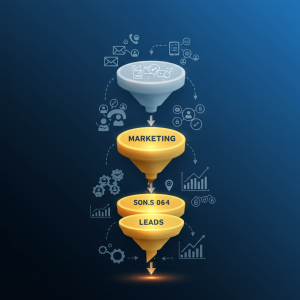What is Inbound vs Outbound Product Marketing?

Whether you’re launching a new product or scaling an existing one, product marketing plays a crucial role in connecting audiences with your offerings. But product marketing isn’t a one-size-fits-all strategy. Two primary approaches define this discipline: inbound and outbound product marketing.
Understanding the difference between inbound and outbound product marketing is not just a theoretical exercise; it’s essential for tailoring your marketing strategy to your goals, audience, and resources. This blog will break down these two approaches, explore their strengths and weaknesses, and help you decide when and how to implement each one.
What is Product Marketing?
Before we dig into inbound and outbound product marketing, it’s worth clarifying what product marketing means. Product marketing focuses on bringing a product to market, driving demand and adoption, and maintaining the product’s appeal throughout its lifecycle.
Unlike general marketing, which broadly builds brand awareness, product marketing hones in on specific products. It covers everything from identifying target audiences and messaging to crafting go-to-market strategies and gathering customer feedback.
Now, let’s explore the two key approaches within product marketing.
What is Outbound Product Marketing?
Outbound product marketing involves proactively reaching out to audiences with your message. This is the more traditional form of product marketing, where the marketer actively puts the product in front of the audience through specific channels.
How Does It Work?
Outbound marketing often includes paid campaigns, direct outreach, and advertising tactics. The idea here is to “push” your message to the target audience rather than waiting for them to come to you. Channels commonly used in outbound product marketing include:
- Paid advertising (Google Ads, social media ads, display ads)
- Product launch events (conferences, trade shows, webinars)
- Cold outreach (email campaigns, cold calls)
- Media and PR (press releases, influencer partnerships)
Imagine you’re launching a new project management tool. An outbound strategy might involve buying ad space on platforms frequented by project managers, hosting product demos, and emailing case studies to potential users.
Benefits of Outbound Product Marketing
Why use outbound product marketing? Here are a few key reasons:
- Fast Reach: Outbound methods allow for quick distribution of your message to masses of people, which can be ideal for product launches.
- Brand Awareness: Paid ads and PR can position your product in front of an audience that may not have known you existed.
- Targeted Outcomes: By using data-driven advertising, outbound campaigns can be tailored to specific demographics or industries.
Challenges of Outbound Product Marketing
Outbound doesn’t come without its challenges:
- Higher Costs: Paid ads and media outreach can rack up significant expenses.
- Potentially Intrusive: Some users perceive outbound efforts like cold calling or aggressive ads as disruptive or annoying.
- Lower Engagement Rates: Users may tune out messages that don’t feel relevant or personalized.
What is Inbound Product Marketing?
Inbound product marketing flips the script. Instead of “pushing” out messages to your audience, inbound marketing focuses on “pulling” them in by providing valuable content, tools, or resources. The audience comes to you because they find your content helpful or engaging.
How Does It Work?
Inbound marketing relies on organic growth and content-driven strategies. Typical inbound product marketing efforts include:
- Content Marketing (blogs, eBooks, whitepapers, how-to guides)
- SEO Optimization to ensure your product is visible in search engines
- Email Newsletters to nurture potential customers over time
- Social Media Engagement (organic storytelling and community building)
- User Reviews to showcase product success stories
For example, with your project management tool, an inbound strategy might involve creating blog posts on common project management challenges, offering a free trial, and sharing user success stories on LinkedIn.
Benefits of Inbound Product Marketing
Inbound marketing offers distinct advantages:
- Builds Credibility: High-value blogs, guides, and reviews position your product as trustworthy and authoritative.
- Cost-Effective: While it requires an upfront investment in content creation, inbound tactics often deliver long-term benefits at a lower cost.
- Attracts Qualified Leads: Since inbound users actively seek out your content, they’re often more interested and likely to convert.
- Lasting Relationships: By building trust over time, inbound approaches often lead to loyal customers.
Challenges of Inbound Product Marketing
That said, inbound marketing has its own hurdles to overcome:
- Takes Time: Building organic traffic and nurturing leads is a long-term game, not an instant win.
- SEO Competition: Achieving and maintaining visibility in search results requires time and skill.
- Resource-Intensive: High-quality content creation and consistent audience engagement demand significant effort.
Comparing Outbound and Inbound Product Marketing
Key Differences
|
Feature |
Outbound Marketing |
Inbound Marketing |
|---|---|---|
|
Approach |
Push content to the audience |
Pull the audience through valuable content |
|
Churn Speed |
Immediate outreach |
Long-term relationship building |
|
Targeting |
Can target broad or specific groups |
Focuses on interested parties |
|
Costs |
Higher investment in advertising or media |
Lower long-term costs |
|
Message |
Focused on selling |
Focused on educating |
When to Choose Outbound Marketing
- Launching a new product needs high visibility quickly.
- Driving buzz for time-sensitive campaigns or events.
- Reaching an audience unaware of your product or brand.
When to Choose Inbound Marketing
- Building long-term relationships with deeply engaged users.
- Operating with a tighter budget and focusing on ROI.
- Establishing thought leadership and credibility in your industry.
Finding the Right Balance
The truth is, inbound and outbound product marketing aren’t mutually exclusive. Successful strategies often combine elements of both. Consider these use-case examples:
Before Launch:
- Run an outbound campaign with paid ads and media outreach to build excitement.
- Once the product launches, create inbound content like blog posts and guides to educate users.
Ongoing Growth:
- Use inbound strategies to generate leads organically over time.
- Pair with outbound retargeting campaigns to capture new prospects or re-engage users who haven’t converted yet.
Maximizing ROI:
- Track data from both strategies to determine which approach yields the highest engagement or conversions for your product.
Leverage the Power of Balanced Product Marketing Strategies
Choosing between inbound and outbound product marketing isn’t about deciding which is “better.” It’s about understanding your business goals, the preferences of your audience, and how the two approaches can complement each other.
Outreach and visibility often start with outbound initiatives, but securing customer loyalty and trust? That’s where inbound marketing shines. The key is knowing when and where to use each approach for maximum impact.
Need help creating inbound content for your product or running high-impact outbound campaigns? Reach out to our team for expert guidance in crafting the perfect strategy.
Learn more about: Outbound Marketing vs Inbound Marketing





